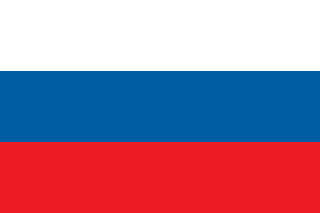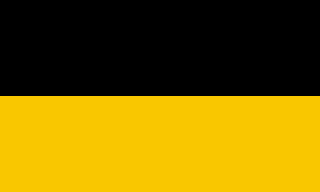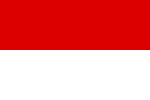
The national flag of Germany is a tricolour consisting of three equal horizontal bands displaying the national colours of Germany: black, red, and gold. The flag was first sighted in 1848 in the German Confederation. It was officially adopted as the national flag of the Weimar Republic from 1919 to 1933, and has been in use since its reintroduction in West Germany in 1949.

Prussia was a German state on the southeast coast of the Baltic Sea. It formed the German Empire under Prussian rule when it united the German states in 1871. It was de facto dissolved by an emergency decree transferring powers of the Prussian government to German Chancellor Franz von Papen in 1932 and de jure by an Allied decree in 1947. For centuries, the House of Hohenzollern ruled Prussia, expanding its size with the Prussian Army. Prussia, with its capital at Königsberg and then, when it became the Kingdom of Prussia in 1701, Berlin, decisively shaped the history of Germany.

The national flag of Spain, as it is defined in the Constitution of 1978, consists of three horizontal stripes: red, yellow and red, the yellow stripe being twice the size of each red stripe. Traditionally, the middle stripe was defined by the more archaic term of gualda, and hence the popular name la Rojigualda (red-weld).

The coat of arms of Germany displays a black eagle with a red beak, a red tongue and red feet on a golden field, which is blazoned: Or, an eagle displayed sable beaked langued and membered gules. This is the Bundesadler, formerly known as Reichsadler. It is one of the oldest coats of arms in the world, and today the oldest national symbol used in Europe.

The Duchy of Carniola was an imperial estate of the Holy Roman Empire, established under Habsburg rule on the territory of the former East Frankish March of Carniola in 1364. A hereditary land of the Habsburg monarchy, it became a constituent land of the Austrian Empire in 1804 and part of the Kingdom of Illyria until 1849. A separate crown land from 1849, it was incorporated into the Cisleithanian territories of Austria-Hungary from 1867 until the state's dissolution in 1918. Its capital was Ljubljana.

The Province of Brandenburg was a province of Prussia from 1815 to 1945. Brandenburg was established in 1815 from the Kingdom of Prussia's core territory, comprised the bulk of the historic Margraviate of Brandenburg and the Lower Lusatia region, and became part of the German Empire in 1871. From 1918, Brandenburg was a province of the Free State of Prussia until it was dissolved in 1945 after World War II, and replaced with reduced territory as the State of Brandenburg in East Germany, which was later dissolved in 1952. Following the reunification of Germany in 1990, Brandenburg was re-established as a federal state of Germany, becoming one of the new states.
The state of Prussia developed from the State of the Teutonic Order. The original flag of the Teutonic Knights had been a black cross on a white flag. Emperor Frederick II in 1229 granted them the right to use the black Eagle of the Holy Roman Empire. This "Prussian Eagle" remained the coats of arms of the successive Prussian states until 1947.

The coat of arms of the German state of Baden-Württemberg features a greater and a lesser version.

The state of Prussia had its origins in the separate lands of the Margraviate of Brandenburg and of the Duchy of Prussia. The Margraviate of Brandenburg developed from the medieval Northern March of the Holy Roman Empire, passing to the House of Hohenzollern in 1415. The Duchy of Prussia originated in 1525 when Albert of Brandenburg-Ansbach, a member of a cadet branch of the Hohenzollerns, secularized the eastern lands of the Teutonic Knights as a Polish fief. Prince-elector John Sigismund, Elector of Brandenburg, inherited the Duchy of Prussia in 1618, thus uniting Brandenburg and Prussia under one ruler in a personal union; the Elector's state became known as Brandenburg-Prussia. The Kingdom of Prussia formed when Elector Frederick III assumed the title of Frederick I, King in Prussia, on 18 January 1701.

This article is about the coat of arms of the German state of Brandenburg.

The Margraviate of Brandenburg was a major principality of the Holy Roman Empire from 1157 to 1806 that played a pivotal role in the history of Germany and Central Europe.

The national colours of the Federal Republic of Germany are officially black, red, and gold, defined with the adoption of the West German flag as a tricolour with these colours in 1949. As Germany was divided into West Germany and East Germany beginning in 1949 and continuing through 1990, both Germanies retained the black, red, and gold colors on each respective flag. After German reunification in 1990, West and East Germany adopted the West German flag as the flag of the reunited Germany, therefore maintaining black, red, and gold as Germany's colors.

The coat of arms of the German federal-state of Lower Saxony shows a white Saxon Steed on a red background.

This article is about the coat of arms of the German state of Mecklenburg-Vorpommern.

The coat of arms of the present-day German free state of Saxony shows a tenfold horizontally-partitioned field of black (sable) and gold/yellow (or) stripes, charged with a green (vert) crancelin running from the viewer's top-left to bottom-right. Although the crancelin is sometimes shown bent (embowed) like a crown, this is due to artistic license. The coat of arms is also displayed on the state flag of Saxony.

The coat of arms German state Thuringia was introduced in 1990. Like the 1949 coat of arms of Hesse it is based on the Ludovingian lion barry, also known as the "lion of Hesse", with the addition of eight mullets.

Both the civil and state flag of the German state of Saxony feature a bicolour of white over green, similar to the Austrian province of Styria although they are historically not related to each other. The state flag is similar to the civil flag, except it is defaced in the centre with the coat of arms of Saxony. The colours of both flags were officially decided as state colours in 1815. The aristocracy used mostly and in first time the quadrangular version and later the rectangular.

The civil flag that serves as the symbol of the state of Mecklenburg-Vorpommern, Germany, consists of five horizontal stripes, that are from the top to bottom: blue (ultramarine), white, yellow, white, and red (vermilion). It was designed by Norbert Buske and adopted on 29 January 1991. It is a combination of the historical flags of the Mecklenburg and Western Pomerania.

The flag of Baden-Württemberg, a state in Germany, has three variants. The civil flag has one design, while the state flag, has two designs. All three flags are a black over gold bi-color, while the state flag has one of two variants of the state arms centered on the flag. The flag, while identical, has no symbolism of or relation with the flag of the Austrian Empire.
 Margraviate of Brandenburg-Küstrin (1535–1571)
Margraviate of Brandenburg-Küstrin (1535–1571) Margraviate of Brandenburg (c. 1684)
Margraviate of Brandenburg (c. 1684) Margraviate of Brandenburg (1660–1750)
Margraviate of Brandenburg (1660–1750) Ensign of Brandenburg Navy
Ensign of Brandenburg Navy  Prussian Province of Brandenburg (1815–1945)
Prussian Province of Brandenburg (1815–1945) Land Brandenburg (1945–1952)
Land Brandenburg (1945–1952)






















